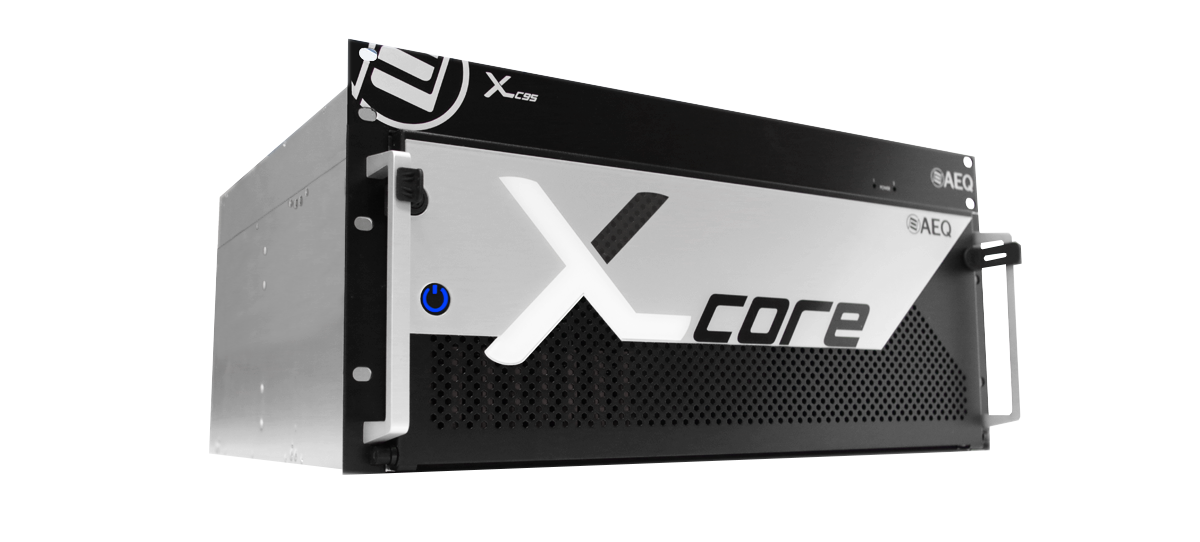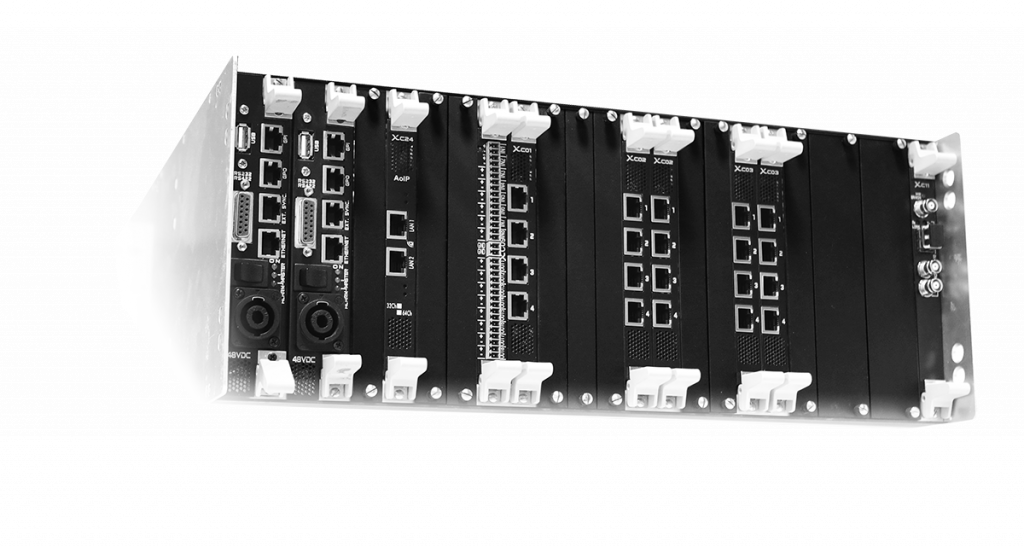X_CORE
Quinta generación de matrices de enrutamiento de audio digital de AEQ
Diseñado para flujos de trabajo altamente intensivos en los más
exigentes escenarios
Integra la capacidad de manejar SDI
audio embebido en vídeo
Sistema de enrutamiento AoIP
Con más de mil canales por matriz, es posible configurar sistemas con una capacidad total
de más de cinco mil canales. X_Core es el resultado de más de 20 años de experiencia en el diseño y la construcción de sistemas matriciales de enrutamiento de audio digital para aplicaciones broadcast.


X_Core Características técnicas
– Capacidad máxima: Bloques de 1.024 circuitos. Se pueden realizar configuraciones de hasta 5.080 x 5.080 circuitos enlazando varios bloques con el concentrador TITAN.
– Protección contra la radiofrecuencia.
– Entradas de micrófono y línea balanceadas electrónicamente. Salidas analógicas de auriculares.
– Entradas y salidas analógicas de línea balanceadas electrónicamente. Disponible opción de entradas y salidas analógicas de línea balanceadas por transformador.
– Entradas/salidas digitales configurables como: AES/EBU (AES3) y SPDIF, mono y estéreo.
– Entradas/salidas digitales agrupables según AES10 (MADI), mono y estéreo, uno o dos interfaces de 64 canales, 48 kHz, fibra monomodo, o multimodo con receptáculos SFP y cartuchos extraíbles.
– Entradas/salidas de audio por IP, comprimido en G722 para intercomunicación, 12 canales por tarjeta.
– Entradas/salidas de audio por IP, protocolo Dante, compatible AES67 y SMPTE ST 2110-30, 64 canales por tarjeta, 48 kHz.
– Entradas/salidas de audio por IP, protocolo RAVENNA, compatible AES67, SMPTE ST 2110-30 y SMPTE ST 2110-31. Control NMOS. 128 canales por tarjeta, 48 kHz.
– Entradas/salidas de audio digital embebidas en vídeo SDI/ 3G, de acuerdo con SMPTE 259 M, 292 M y 424 M. Cada tarjeta dispone de dos interfaces de entrada y dos de salida con 2×16 entradas y 2×16 salidas de audio.
– GPI y GPO (Entradas y salidas de propósito general para aplicaciones especiales):
– Por optoacoplador en algunas tarjetas de entradas y salidas.
– GPI por optoacoplador y GPO por relé en las tarjetas controladoras.
– Sincronismo interno a través de todo el sistema X_CORE. Acepta y entrega sincronismo a través de conexiones WORDCLOCK y AES11, además de a través de señales AES/EBU, AES10, DANTE (PTPv1 y PTPv2) AES67 (PTPv2) y RAVENNA (PTPv2). También se acepta la sincronización desde la entrada Genlock de la tarjeta SDI.(PTPv2) y RAVENNA (PTPv2).
– Frecuencia de muestreo interna 48 kHz, 24 bits.
– Formato buses internos: dos buses, 32 bits por muestra, coma flotante.
– Funciones de proceso disponibles (modificables por el usuario en tiempo real):
– Enrutado de entradas y salidas.
– Control de ganancia en señales a nivel de línea: -12 dB a +12 dB.
– Control de ganancia en señales a nivel de micro: -40 dB a +24 dB.
– Distribución espacial estereofónica (Balance/Panorama).
– Control de continuidad en la modulación.
– Generadores de Test: ruido rosa y blanco, generadores de tonos con frecuencia configurable y modo burst.
– Dinámica: compresión, limitación, expansión, combinado DLP, puerta de ruido.
– Frecuencia: filtros paso alto, paso bajo, paso banda, ecualización paramétrica de 4 bandas y de-esser.
– Delay.
– Reverb.
Incorpora una placa PC industrial con sistema operativo en tiempo real que se almacena con los datos de configuración en una memoria Compact Flash. Sus funciones son, entre otras:
– Gestionar la configuración del frame y sus relaciones con el exterior.
– Gestionar la temporización de todo el sistema, centralizando las fuentes de sincronismo.
– Gestionar las alarmas de alimentación producidas en cualquiera de las tarjetas, encendiendo el LED «ALARM» si detecta un fallo.
– Gestionar el modo maestro/esclavo (cuando se usan dos tarjetas controladoras).
– Suministrar la alimentación a todo el frame.

